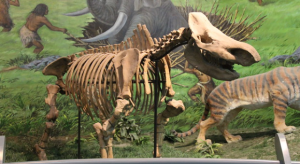When we think of elephants in prehistoric times, the image that immediately comes to mind is that of giant Mammoths.
However, there were ‘dwarf’ elephants the size of small donkeys that once roamed islands in the Mediterranean, while their relatives became giants with ‘grotesque’ bulging heads.
Scientists have long debated whether these different-sized elephant fossils found throughout Europe and Asia were all the same or belonged to two or more species.
Apart from their stark size variations, the prehistoric elephants, known as Palaeoloxodon, had distinctive skull crests — ridges of bone that protruded around their foreheads.
An international team of researchers has now studied variations in these bulging skull crests to sort out the evolutionary history of the straight-tusked animals.
While the first fossils found in India had distinctively thick skull crests compared to those found in Europe, suggesting that they were indeed separate species, the later discovery of Palaeoloxodon skulls with thick skull crests in Europe muddied the waters.
However, experts have now determined that the larger Indian elephants were indeed of a different species from those with smaller skull crests.
more at dailymail.co.uk
Ask me anything
Explore related questions





